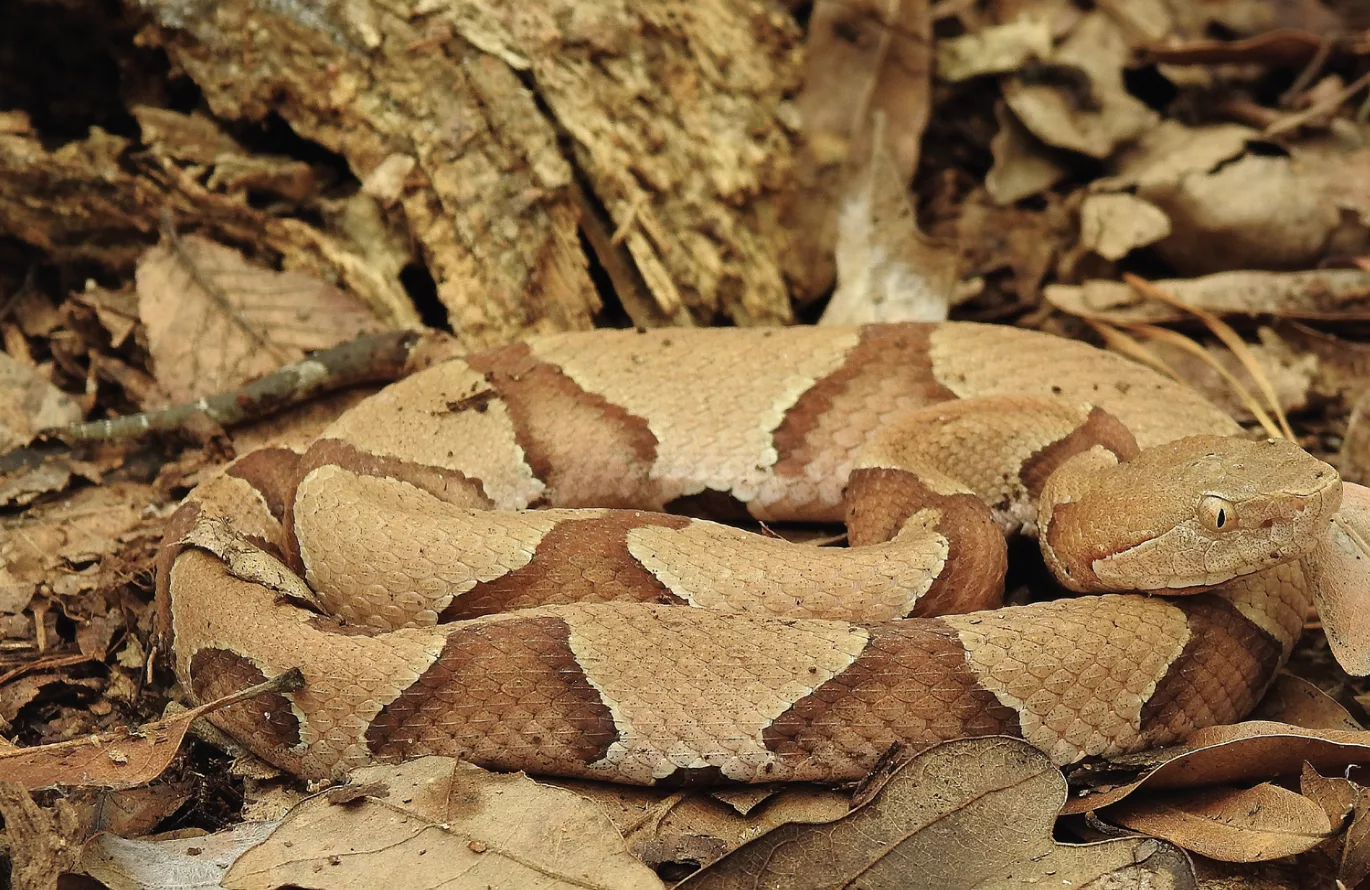
By Jane Noyce
In nature, success is not always about speed or strength. Sometimes, it is about patience, precision, and adaptability. Among Connecticut’s native wildlife, few creatures embody these traits better than the Northern Copperhead. A master of camouflage, this remarkable reptile thrives in plain sight, navigating the modern world without drawing attention to itself. Unlike its louder, more conspicuous counterparts, the copperhead excels by blending in, waiting for the perfect moment, and striking with efficiency. It is a lesson in restraint, focus, and strategic action—principles that humans, too, can apply to achieve success in a rapidly shifting landscape.
The copperhead is one of two venomous snake species in Connecticut, alongside the timber rattlesnake. Unlike its endangered relative, which has suffered from overhunting and habitat loss, the copperhead has persisted, not through brute force but through careful adaptation. Its cryptic coloration allows it to disappear into the forest floor, avoiding unnecessary conflicts. It does not waste energy in fruitless battles but instead relies on patience. Lying motionless in leaf litter or under debris, it waits for the precise moment to strike, ensuring that when it acts, it succeeds.
The Northern Copperhead (Agkistrodon contortrix mokasen) belongs to the pit viper family, meaning it possesses heat-sensitive pit organs located between its eyes and nostrils. These organs allow it to detect warm-blooded prey, even in complete darkness. This evolutionary advantage, combined with its lightning-fast strike, makes the copperhead an efficient hunter. It primarily preys on small rodents, but it also consumes birds, amphibians, insects, and even other reptiles. Unlike many snakes, copperheads are ovoviviparous, meaning their young develop inside the mother and are born live, rather than hatching from eggs. At birth, the young are fully capable of hunting and fending for themselves.
Though venomous, the copperhead is not aggressive. It prefers to remain motionless, relying on its camouflage to avoid detection. When threatened, it may vibrate its tail—a behavior often mistaken for a rattlesnake’s warning. Only when directly provoked or stepped on does it resort to biting. Copperhead venom is hemolytic, meaning it breaks down red blood cells, causing localized pain, swelling, and, in some cases, tissue damage. However, fatalities are exceedingly rare. In Connecticut, copperhead bites are infrequent, with only a handful reported each year. Thanks to modern medical care, bites are almost never life-threatening, but immediate medical attention is advised.
Copperheads thrive in Connecticut’s rocky ridges, forested hillsides, and meadow edges, often near wetlands. They are most active from April through October, particularly at night during the warmer months. To reduce the risk of encounters, hikers and outdoor enthusiasts should stay on clear trails, wear protective footwear, and remain vigilant when stepping over logs or reaching into rocky crevices. Copperheads, like most snakes, prefer to retreat rather than engage—given space, they will simply move on.
The lesson is clear: success often comes not from constant motion but from knowing when to be still. In our world of relentless activity and instant gratification, the copperhead’s strategy reminds us that sometimes the best move is no move at all—until the time is right. The ability to observe, assess, and act only when necessary is a trait shared by the most effective leaders, athletes, and strategists.
The copperhead’s success is also about adaptability. While the timber rattlesnake has seen its numbers dwindle due to human encroachment, the copperhead has found ways to persist. It does not need vast, undisturbed wilderness to survive. Instead, it thrives on the edges—of forests, meadows, and even suburban developments. It adjusts to changing conditions without compromising its fundamental nature. This is a key to resilience in any field, from business to personal development. Those who can adapt without losing their core strengths are the ones who endure.
The copperhead also teaches the value of measured action. When threatened, it does not immediately lash out. It remains still, allowing potential threats to pass. Even when confronted, it often issues warnings—vibrating its tail like a rattlesnake or adopting a defensive posture. Only when there is no other option does it strike, and when it does, it does so with precision. Its venom is not wasted but used efficiently.
The copperhead does not engage in unnecessary conflicts, distractions, and reactions to minor provocations. The copperhead reminds us that not every challenge requires a response. Measured, purposeful action is more effective than constant reaction.
Perhaps most remarkably, the copperhead survives despite being widely misunderstood. Feared and persecuted, it has endured countless attacks from humans who mistake it for something more dangerous than it is. Yet, rather than becoming aggressive, it has persisted by relying on the same strategies that have always worked—blending in, waiting, adapting. At times when misunderstanding and misrepresentation are common, this is a lesson in the power of quiet confidence.
Patience, precision, and resilience—traits that we would do well to adopt. Perhaps the copperhead offers the greatest lesson of all: True success is not about being the most visible. It is about knowing when to move, when to wait, and how to strike with purpose.
True success isn’t about being the loudest or the most aggressive. It’s about knowing when to move, when to wait, and how to act with purpose.



